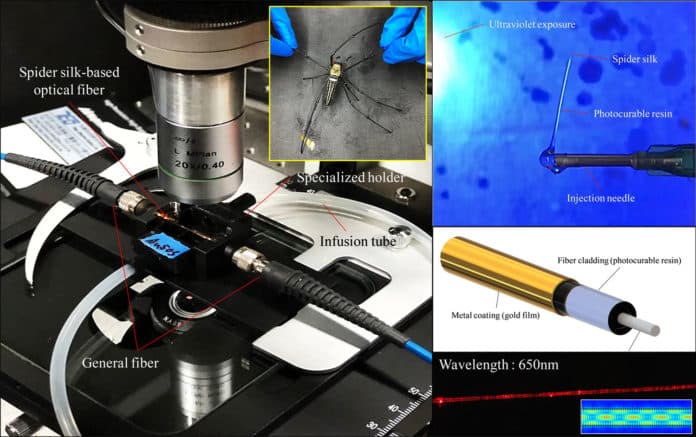Spider silk poses superior properties such as elasticity, tensile strength, biodegradability, and biocompatibility. Because of these properties, various optical components employed in biomedical applications have been fabricated using spider silk.
In this study, researchers from Taiwan Instrument Research Institute and Taipei Medical University have developed a highly sensitive fiber optic sugar sensor by harnessing the light-guiding properties of spider silk. The sensor can detect and measure small changes in the refractive index of a biological solution, including glucose and other types of sugar solutions.
Research team leader Cheng-Yang Liu from National Yang-Ming Chiao Tung University in Taiwan said, “Glucose sensors are crucial to people with diabetes, but these devices tend to be invasive, uncomfortable, and not cost-efficient. With spider silk attracting attention for its superior optomechanical properties, we wanted to explore using this biocompatible material to detect various sugar concentrations in real-time optically.”
The sensor is practical, reusable, compact, biocompatible, cost-effective, and highly sensitive. It can be used to determine concentrations of fructose, sucrose, and glucose sugars based on changes in a solution’s refractive index. As it is compact, it could allow access to hard-to-reach areas such as the brain and heart.
To develop the sensor, researchers harnessed the dragline spider silk from the giant wood spider Nephila pilipes. The silk, which has a diameter of only 10 microns, was encased in a biocompatible photocurable resin before being cured to create a smooth protective surface. As a result, a 100 micron-diameter optical fiber structure was made, with spider silk serving as the core and resin as the cladding. They then enhanced the fiber’s sensing capabilities by coating it with a biocompatible nanolayer of gold.
This procedure produced a two-ended, thread-like structure. The fibre was attached to a light source and a spectrometer on one end, and the other end was submerged in a liquid sample for measuring purposes. This made it possible for the researchers to identify the solution’s refractive index and use it to ascertain the kind of sugar and its concentration.
Research team leader Cheng-Yang Liu from National Yang-Ming Chiao Tung University in Taiwan said, “With further development, it could lead to better at-home medical monitoring devices and point-of-care diagnostic and testing devices.”
The researchers tested the sensors’ repeatability and stability by measuring solutions with unknown concentrations of fructose, sucrose, or glucose sugars at room temperature. They quantitatively determined the sensor’s performance by comparing light intensity spectra produced by the sensor with refractive index measurements acquired with a commercial refractometer. The sensor was able to both identify the type of sugar in the solution and provide a readout of the concentration.
Liu said, “The measurement precision and sensing sensitivity we achieved suggests that the sensor can accurately estimate the concentration of an unknown sugar solution. Moreover, the sensing sensitivity for our proposed sensor completely encompasses the range of sugar concentrations found in human blood.”
Journal Reference:
- Hsuan-Pei E, Jelene Antonicole Ngan Kong et al. Biocompatible spider silk-based metal-dielectric fiber optic sugar sensor. Biomedical Optics Express, 2022; 13 (9): 4483 DOI: 10.1364/BOE.462573
